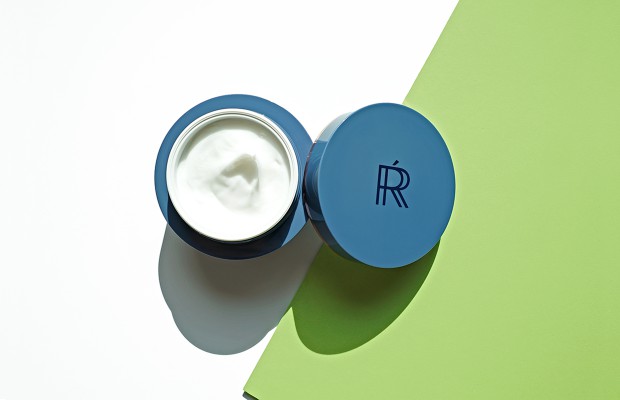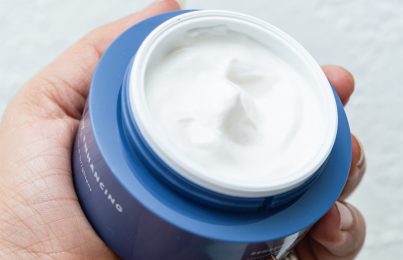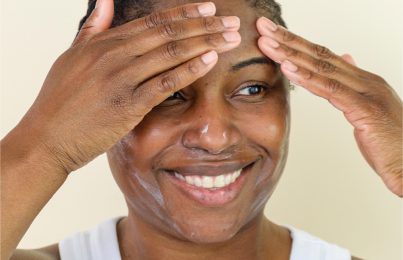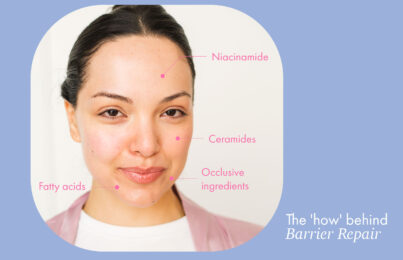For those of you who have dry skin, using a heavy, rich, and thick moisturizer seems like the obvious choice to provide much-needed moisture. But what if you are using what feels like a good moisturizer, yet your skin is still dry, flaky, or even itchy? The reason for this may be that you are using a poorly formulated moisturizer.
Finding the right moisturizer to hydrate dry skin lies in the ingredients used in the formula – ones that actually repair what causes dry skin. There have been many breakthroughs in the science of moisture retention and it all comes down to choosing the right ingredients.
Let’s take a look at what causes dry skin, the ingredients to look for, which ones to avoid, and how to choose the best moisturizer for dry skin.
What Causes Dry Skin and How Does a Good Moisturizer Help?
The first thing you should know is that dry skin is different than dehydrated skin in that it lacks oil—not water. Since the skin relies on oil to retain moisture, lacking it means you have a compromised skin barrier. Translation? Your skin starts to exhibit all the negative characteristics of dry skin you’re already familiar with, including texture issues and advanced signs of aging. Dry skin can also act more sensitive due to the disruption in your skin barrier. When healthy, this barrier acts as a shield to keep irritants out.
It’s fairly easy to tell if you have dry skin based on how it looks and feels. Generally speaking, dry skin will have a rough texture, minimal breakout activity, small-to-medium pore size, and increased sensitivity and redness. Often, people who have dry skin struggle with a dull complexion, which is why I recommend using energizing products to boost circulation (such as the Energy Boosting Toner).
By finding a good moisturizer, you can not only nourish the skin, but also form a protective layer on the skin’s surface, preventing moisture loss and external irritants from penetrating. They can also help soothe irritation and itchiness associated with tight, dry skin.
If you’re still unsure of whether or not you have dry skin, I encourage you to take the Skin Type Quiz. It’s the easiest way to learn about your skin type. Just answer a few simple questions, and it will give you an accurate result, along with personalized product recommendations.
What is a damaged lipid barrier?
Your skin has a moisture barrier made of natural lipids that keep moisture in the skin and irritants out. When this barrier is damaged, it creates tiny, invisible cracks in the skin that allow moisture to escape (causing dry, flaky skin) and irritants to enter more easily (making even sensitive skin products cause a stinging, irritating sensation).
To repair dry, flaky skin, look for the following soothing, barrier-repairing ingredients when choosing a moisturizer.
Best Skincare Ingredients that Help Repair Dry Skin
Plant Oils
Remember how I said dry skin lacks oil? An easy way to give it what it needs is to use skincare products that contain certain plant oils. Personally, I love jojoba oil, rosehip seed oil, and borage seed oil. They’re full of fatty acids that can help support and repair the lipids in the moisture barrier. Other great options include:
- Bois De Rose Oil
- Carrot Oil
- Evening Primrose Oil
- Cranberry Oil
- Sunflower Oil
- Soybean Oil
- Safflower Oil
- Sweet Almond Oil
- Canola Oil
- Sesame Seed Oil
Ceramides
Ceramides are lipids that play a large role in supporting the moisture barrier. They act as a skin protectant and moisturizer, which is why you’ll often find them in restorative products formulated for sensitive skin types.
You can find ceramides in the Pure Radiance Creme Masque. I formulated this mask with a combination of moisturizing plant oils to leave dry skin smooth, supple, and comfortable.
Linoleic/Linolenic Acids
These essential fatty acids are key components of the skin’s natural barrier, helping to strengthen the skin’s protective barrier, improve hydration, reduce inflammation, and make skin softer and smoother overall.
Squalane
This ingredient is fantastic for keeping skin moisturized, as it not only mimics the natural oils that our skin produces, but also is a lightweight way to boost hydration. It absorbs quickly, is non-comedogenic, and provides additional antioxidant properties as well.
Linoleic Acid
This omega-6 fatty acid acts as a building block for the lipids that form the skin’s protective layer, preventing moisture loss and protecting from irritants.
Tocopheryl Linoleate
A form of vitamin E, this is particularly helpful not only in providing a boost of hydration, but also protecting the skin from environmental aggressors and soothing dry, irritated skin.
Phytosterols
Essentially, these help restore and maintain the skin’s barrier by mimicking the skin’s natural lipids, locking in hydration, and reducing inflammation, keeping skin balanced.
Shea Butter
This ingredient is a botanical extract that acts as an emollient, meaning it softens the skin and seals in moisture. It’s barrier-repairing and skin-protecting, and it’s considered safe for sensitive skin types since it’s known to soothe irritation.
You can find shea butter in multiple Renée Rouleau moisturizers.
These ingredients will correct both the lack of oil and lack of hydration deep within your skin and actually repair the skin’s lipid moisture barrier to make your skin moist, supple, and smooth. It’s a fact that hydrated skin is healthy skin, so start looking at your ingredient labels to find the perfect moisturizer for your dry, flaky skin.
Other Ingredients that Repair Your Skin Barrier
There are many more barrier-repair ingredients, but the ones listed above are some of the more common moisturizing agents and the ones I like to use in the Renée Rouleau product line.
Best Overall Moisturizer for Dry, Flaky Skin
When it comes to dry skin, there are two superstar moisturizers that come to mind.
For dull skin in need of a boost, there’s nothing better than Glow Enhancing Creme. This luxurious cream formulation delivers vital lipid rich oils to repair the skin’s damaged moisture barrier. This cream will hydrate and plump skin.
If your dryness stems from retinol or retinoid-use, over-exfoliation, laser treatments, chemical peels, accutane, eczema, or rosacea, then I highly recommend Phytolipid Comfort Creme. This is the perfect way to restore and calm the skin. Using an age-defying formula with advanced moisturizing lipids and calming plant extract, this effectively makes skin less dry and sensitive over time.
Best Moisturizer for Oily Skin
For those of you with sensitive, breakout-prone skin, it’s best to seek out lightweight, oil-free moisturizers, like Skin Recovery Lotion. This moisturizer uses water-binding hydrators like hyaluronic acid and glycerin to address all symptoms of a compromised barrier, including dehydration, flaking, and redness caused by harsh acne treatments.
If you only experience the occasional breakout but are looking for hydration and anti-aging results, Sheer Moisture Lotion is the perfect choice. Using time-released antioxidants and niacinamide, this high-performance lotion offers brightening benefits, exceptional hydration, and leaves skin feeling plump, without clogging pores.
Using a Skin Oil for Dry Skin
If you prefer using a skin oil for your dry, flaky skin, that is totally fine. As the Head of New Product Development at Renée Rouleau Skin Care, I am happy to share that we have something special in the works… Stay tuned!
Skincare Ingredients to Avoid if Your Skin is Dry
It’s just as important to know which ingredients to avoid when caring for dry skin. Here are a few I suggest staying away from…
Drying Alcohols
If you’re a regular reader of my blog, you know I dislike drying alcohol ingredients, like SD Alcohol 40, Denatured Alcohol, Ethanol, and Isopropyl Alcohol. These are found in many skincare products, but I can’t stand to see them in toners. That’s because toners are meant to hydrate the skin, and these ingredients can strip moisture and cause excess dryness. It doesn’t make much sense, does it? That’s why all Renée Rouleau toners are alcohol-free!
The only exception to this rule is acne spot treatments. Sometimes, these drying ingredients can be beneficial for drying out blemish-causing bacteria. Since dry skin types have minimal breakout activity in the first place, I’d recommend avoiding them.
Sulfates
Sulfates are used as cleansing agents, which is why they’re commonly found in cleansers. Like the aforementioned alcohols, sulfates can strip too much moisture from the skin, causing dryness. That’s why I recommend avoiding skincare products that list ingredients like Sodium Lauryl Sulfate or Ammonium Lauryl Sulfate on their labels.
Be sure to avoid any product that leaves your skin feeling tight. Look at your cleansers and make sure to avoid the ingredients Sodium Laureth Sulfate and Ammonium Laureth Sulfate, as these only further damage the skin’s barrier. If you’re using the wrong cleanser, you’re instantly stripping moisture out of the skin, which is the worst thing you can do for dry skin.
All Renée Rouleau cleansers are sulfate-free so you can rest assured they won’t strip moisture from your skin!
Moisturizers Don’t Have To Be Greasy!
Surprisingly, a moisturizer for dry skin doesn’t need to be greasy, oily or even thick. If you have used any of the Renée Rouleau moisturizers, you may notice that the ones for dry skin aren’t really that heavy.
Many of my clients think they need something with a greasier texture, but this is simply not the solution. What is important is that it is loaded with a blend of barrier-repairing ingredients that, with continued use, will help the skin retain its moisture. This will alleviate any tightness and flakiness due to dryness, instead leaving skin moist, supple, and perfectly hydrated.
Also, note that humectant ingredients like glycerin, hyaluronic acid, sodium hyaluronate, sorbitol, urea, and sodium PCA all help to attract water from the dermis into the epidermis, which is a good thing, but these alone will not solve dry skin.
Don’t Forget to Exfoliate
When it comes to dry, flaky skin, exfoliation is very important and is a part of a skin care routine that shouldn’t be overlooked. Dry skin often accumulates dead skin cells, causing that flaky texture that so many of us experience. Removing this buildup will leave your skin visibly brighter and smoother, allowing hydrating serums and moisturizers to penetrate more effectively.
Celebrity Esthetician & Skincare Expert
As an esthetician trained in cosmetic chemistry, Renée Rouleau has spent 30 years researching skin, educating her audience, and building an award-winning line of products. Her hands-on experience as an esthetician and trusted skin care expert has created a real-world solution — products that are formulated for nine different types of skin so your face will get exactly what it needs to look and feel its best. Trusted by celebrities, editors, bloggers, and skincare obsessives around the globe, her vast real-world knowledge and constant research are why Marie Claire calls her “the most passionate skin practitioner we know.”




Comments:
Hi Renee,
What do you think of the new hype– face oils, such as maracuja oil or argan oil? I notice that you don’t sell face oils– do you not think they are good for skin? Do they cause breakouts? I have very dry skin, but I also get breakouts, and I think using face oils may have caused my recent breakouts on my forehead. But I do love how face oils make my skin look and feel… my dryness has gone away!
Do you have any opinions with regard to this?
Thanks!!
Emily
Posted By: Emily |
Hi Emily, I’m actually developing a facial oil right now but here’s my general opinion. I don’t think facial oils are appropriate or acne-prone skin. The reason is because oil breeds bacteria and bacteria leads to breakouts so with skins with breakouts, you just don’t want to add oil. If you’re feeling dry, you should focus on using a really gentle cleanser (make sure it’s sulfate-free) and using an alcohol-free toner leaving it damp on the skin before applying a serum and moisturizer. There are other ways to hydrate the skin without risking breakouts from using oils. If you have dry skin yet you still get breakouts, your routine isn’t working for you. Be sure to take our Skin Type Quiz for product recommendations. https://www.reneerouleau.com/quizzes/1/questions/1
Posted By: Renée Rouleau |